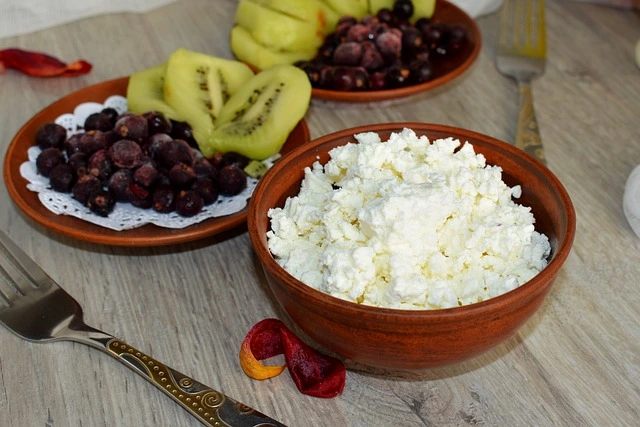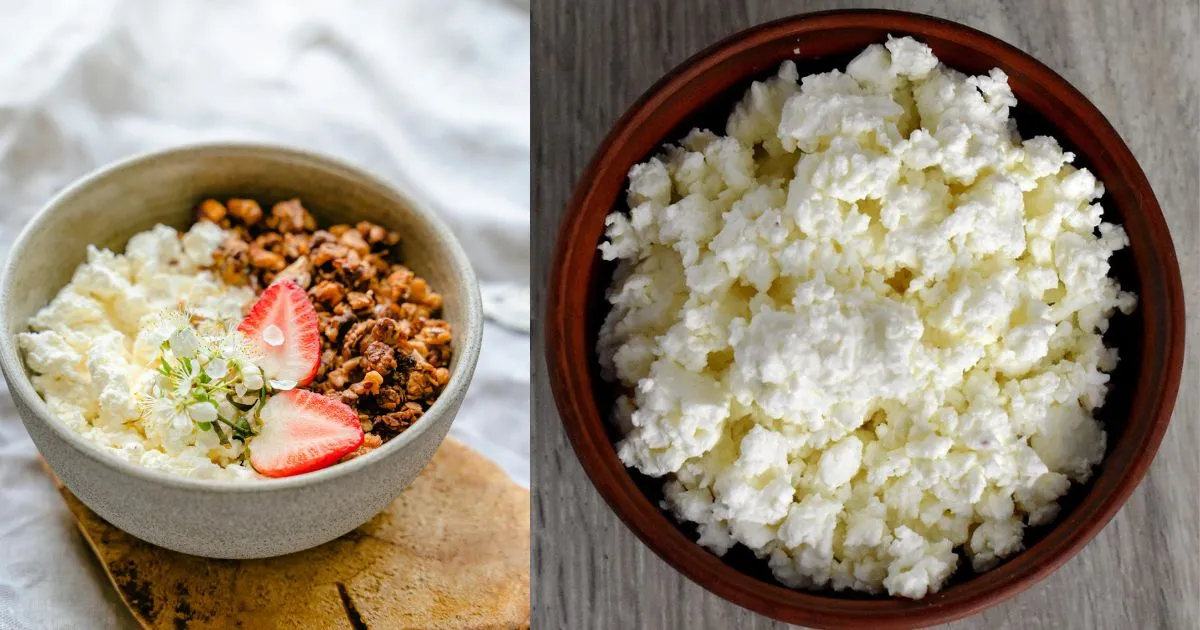Cottage cheese, a staple in many kitchens, is both versatile and nutritious. Known for its mild flavour and lumpy texture. Unlike aged cheeses, cottage cheese is not fermented but rather curdled and then drained, which gives it its distinctive, slightly tangy taste.
Cottage cheese is a curdled milk product with a mild flavour and a creamy, heterogeneous, soupy texture made from the curds of pasteurized cow’s milk. The curds are drained but not pressed during production, resulting in a creamy, lumpy texture that sets it apart from other cheeses.
Cottage cheese comes in various forms, such as small or large curd, low-fat, or regular, allowing you to choose based on your dietary preferences.
The main difference from the other fresh cheeses in the manufacturing process is the addition of a “dressing” to the curd grains, usually cream, which is mainly responsible for the taste of the cheese.
Often lauded for its health benefits, cottage cheese is low in fat and high in protein, making it an excellent choice for those looking to maintain a balanced diet.

With approximately 11-12% protein and just around 4% fat, it’s a favourite among fitness enthusiasts and health-conscious eaters.
Cottage cheese can be low in calories compared to other types of cheese similar to yoghurt, which makes it popular among dieters and some health devotees. It can be used with various foods such as yoghurt, fruit, toast, and granola, in salads, and as a dip.
Top 12 Facts About Cottage Cheese:
- Source of Milk: Cow milk
- Texture: Lumpy and curd-like with a creamy base
- Colour: White
- Flavour: Mild, slightly tangy, and creamy
- Fat Content: 1-4% (varies by type)
- Aging Time: Fresh, not aged
- Pasteurized: Usually pasteurized
- Country of Origin: United States
- Town: Produced in various locations
- Named After: The cheese’s original production in cottages
- Certification: No specific certification
- Uses: Ideal for salads, snacks, and baking
ALSO READ: The Ultimate Guide to Cheddar Cheese
In this post we will discuss about Origin of cottage cheese, uses, Nutritional Benefits, and production:
Origin of cottage cheese
The origins of cottage cheese can be traced back to rural areas of medieval Europe. Farmers and peasants would typically make cheese at home using milk from their cows, goats, or sheep.
In the early 20th century, farmers in northeastern British Columbia made something they called “homesteader’s cheese,” which is said to have been similar to modern industrial cottage cheese.
Cottage cheese was widely promoted in America during the First World War, along with other dairy products, to save meat for infantry rations. This promotion was shown in many war posters.
Simple Production: Cottage cheese is believed to have originated as a simple form of cheese-making where milk was curdled using acidic substances like lemon juice or vinegar. The curds would separate from the whey, and these curds were then drained and lightly pressed, resulting in a soft, lumpy cheese.
Naming origins: The name “cottage cheese” itself reflects its historical roots. The term “cottage” refers to the small rural cottages or farmhouses where farmers would make this cheese using basic equipment and simple techniques.
Variation in Names: In different regions and cultures, cottage cheese is known by various names. For instance, in the United Kingdom and some Commonwealth countries, it’s often referred to as “curds and whey,” reflecting its basic ingredients and production process.

ALSO READ: Exploring Parmesan or Parmigiano-Reggiano cheese
Nutritional Benefits
Protein Powerhouse: Cottage cheese is renowned for its high protein content, making it an excellent choice for those looking to boost their protein intake. A single cup of cottage cheese can provide around 25 grams of protein, which is crucial for muscle repair and overall health.
Rich in Nutrients: Beyond protein, cottage cheese contains essential nutrients like calcium, phosphorus, B vitamins (especially riboflavin and vitamin B12), and selenium. These nutrients support bone health, metabolism, and immune function.
Low in Calories: For those watching their calorie intake, cottage cheese can be a satisfying option. It’s relatively low in calories compared to many other cheese varieties, especially when you choose low-fat or fat-free options.
How to make cottage cheese
Cottage cheese production, whether on a small scale or commercially, involves several key steps to ensure quality, consistency, and safety.
Since the 1930s, cheese factory using pasteurized skim milk, to produce cottage cheese. In more modern processes using concentrated nonfat milk or reconstituted nonfat dry milk.
Let us see the factors involved in producing cottage cheese
1. Milk Reception and Standardization:
- Milk Source: High-quality milk is sourced from dairy farms and transported to the processing facility under controlled conditions to maintain freshness and safety.
- Quality Control: Upon arrival, the milk undergoes quality testing for parameters such as temperature, acidity, and potential contaminants to ensure it meets regulatory standards.
- Standardization: Depending on the desired fat content of the final product, the milk may undergo standardization where the fat content is adjusted by blending different milk streams (whole milk, skim milk) to achieve the desired percentage.
2. Pasteurization
Heating: The milk is heated to a specific temperature (typically around 161°F or 72°C) for a specified time to kill harmful bacteria and pathogens while preserving beneficial enzymes and nutrients.
3. Culturing
Inoculation: After pasteurization, a starter culture containing specific strains of bacteria (often lactic acid bacteria such as Lactococcus lactis and Lactococcus cremoris) is added to the milk. These bacteria ferment the lactose (milk sugar) into lactic acid, which lowers the pH of the milk and helps develop the characteristic flavour and texture of cottage cheese.
ALSO READ: Mozzarella cheese
4. Coagulation and Cutting
- Coagulation: Once the milk reaches the desired acidity level, rennet or another coagulant may be added to aid in the coagulation process. This causes the milk to form a gel-like structure composed of curds (solid) and whey (liquid).
- Cutting: The coagulated milk is then cut into small curds using knives or blades. The size of the curds can vary depending on the desired texture of the cottage cheese—larger curds for a chunkier texture or smaller curds for a smoother consistency.
5. Cooking and Draining
- Cooking: The curds are gently heated while stirring to firm them up and expel more whey. This process helps develop the characteristic texture of cottage cheese.
- Draining: The curds and whey are separated by draining through a mesh or perforated surface. The whey is collected for further processing or disposal, while the curds continue on to the next stage.
6. Washing and Salting
- Washing: The curds may be washed with cold water to remove residual lactose and acidity, as well as to cool them down.
- Salting: Salt may be added to the curds for flavour enhancement and preservation. The amount of salt added can vary depending on the desired taste profile of the cottage cheese.
7. Packaging and Storage
- Packaging: The cottage cheese is packaged into containers, which can range from small individual servings to large bulk containers depending on the market and consumer preferences.
- Refrigeration: Finished cottage cheese is stored under refrigeration to maintain freshness and extend shelf life. Proper temperature control is crucial to prevent spoilage and maintain quality.
ALSO READ: The Ultimate Guide to Ricotta Cheese
Uses of cottage cheese
Cottage cheese is a versatile ingredient that can be used in a variety of ways in both savory and sweet dishes. Its mild flavor and creamy texture make it a popular choice for adding protein and richness to meals. Here are some common and creative ways to use cottage cheese in your culinary adventures:
1. As a Standalone Snack:
Enjoy cottage cheese on its own as a quick and nutritious snack. Sprinkle it with a bit of salt and pepper, or drizzle with honey for a sweet touch. You can also top it with fresh fruits like berries or sliced peaches.
2. In Salads:
Add cottage cheese to salads for a creamy texture and protein boost. It pairs well with fresh greens, tomatoes, cucumbers, and avocado. Try it in a classic garden salad or a hearty spinach salad.
3. In Sandwiches and Wraps:
Use cottage cheese as a spread or filling for sandwiches and wraps. It adds a creamy element without the heaviness of mayonnaise or other spreads. Combine it with vegetables, herbs, and your choice of protein for a satisfying meal.
4. In Smoothies:
Blend cottage cheese into smoothies for added creaminess and protein. It works particularly well in fruit smoothies where it can complement flavours like banana, mango, or pineapple. You can also add a spoonful to your favourite green smoothie for an extra protein boost.
5. In Baked Goods:
Cottage cheese can be used in baking to add moisture and richness to recipes. Incorporate it into muffins, pancakes, and quick breads for a tender texture. It can also be used in cheesecakes and other desserts for a creamy filling.
6. In Pasta Dishes:
Use cottage cheese as a healthier alternative to ricotta cheese in pasta dishes like lasagna, stuffed shells, or baked ziti. Mix it with herbs and spices for added flavour before layering it with pasta and sauce.
7. In Savory Dips and Spreads:
Blend cottage cheese with herbs, garlic, and lemon juice to create a delicious savoury dip or spread. Serve it with raw vegetables, crackers, or as a topping for baked potatoes.
8. In Breakfast Dishes:
Incorporate cottage cheese into your breakfast routine. Use it as a topping for oatmeal or yoghurt bowls, or mix it into scrambled eggs or omelettes for added creaminess and protein.
9. In Desserts:
Cottage cheese can be used in desserts such as cheesecake, and pancakes, or even blended into creamy fruit desserts. Its mild flavour makes it versatile for both sweet and savoury applications.
10. As a Healthy Substitute:
Substitute cottage cheese for higher-fat cheeses or creamy ingredients like sour cream or cream cheese in recipes to reduce calories and boost protein content.
Tips for Using Cottage Cheese:
- Texture Control: If you prefer a smoother texture, blend cottage cheese in a food processor or blender before using it in recipes.
- Flavour Enhancement: Season cottage cheese with herbs, spices, or a drizzle of olive oil to enhance its flavor.
- Storage: Store opened cottage cheese in the refrigerator and consume it within a few days for optimal freshness.
ALSO READ: Complete guide to Feta cheese
To learn about the origin uses, and nutritional benefits of cottage cheese, explore its historical significance and production process. For more, visit Wikipedia’s Cottage Cheese page and Cheese.com.
FAQ
What is cottage cheese?
Cottage cheese is a fresh cheese made from curds that are drained of their whey. It has a creamy texture and mild flavor, making it a versatile ingredient in various dishes.
What are the nutritional benefits of cottage cheese?
Cottage cheese is high in protein, low in fat, and a good source of calcium and other essential nutrients. It is often favored for weight management and muscle recovery due to its high protein content.
How can I use cottage cheese in cooking?
Cottage cheese can be used in numerous ways, such as in salads, smoothies, baked goods, and as a topping for fruits. It can also be blended into dips or used as a substitute for ricotta in recipes.
Is cottage cheese suitable for weight loss?
Yes, cottage cheese is often recommended for weight loss diets due to its high protein content and low calorie count. It helps keep you full and satisfied while providing essential nutrients.
More on Cheese
- Exploring Parmesan or Parmigiano-Reggiano cheese
- Mozzarella cheese | Origins, Production, uses
- The Ultimate Guide to Ricotta Cheese
- Homemade Ricotta Cheese Recipe
- Complete guide to Feta cheese
- The Ultimate Guide to Danish Blue Cheese
- The Ultimate Guide to Bel Paese Cheese
- Cream Cheese Essentials: Everything You Need to Know
- Camembert Cheese: A Comprehensive Guide
- 27 different types of cheese: their origin and uses
- Service of cheese in restaurants
Subscribe and join our community of hospitality professionals & students — get insights, tips, and the latest updates delivered straight to your inbox!







